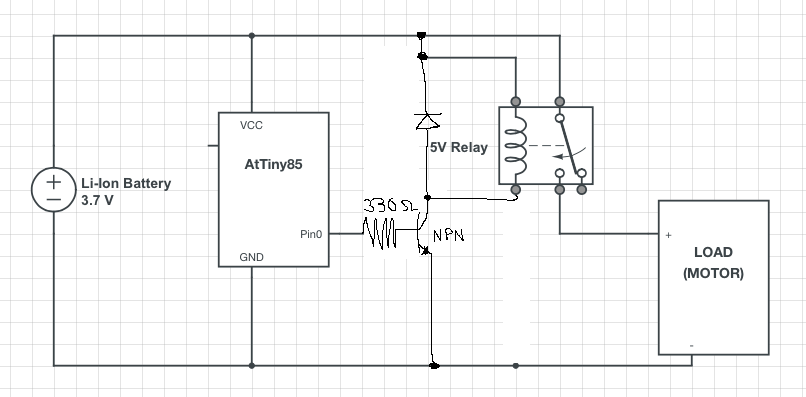I am trying trying to control a 5V relay (SRD-05VDC-SL-C) with the ATtiny85. I have a simple sketch uploaded (Blink without Delay example):
const int ledPin = 0; // the number of the LED pin
int ledState = LOW; // ledState used to set the LED
unsigned long previousMillis = 0; // will store last time LED was updated
const long interval = 1000; // interval at which to blink (milliseconds)
void setup() {
pinMode(ledPin, OUTPUT);
}
void loop()
{
unsigned long currentMillis = millis();
if(currentMillis - previousMillis >= interval) {
previousMillis = currentMillis;
if (ledState == LOW)
ledState = HIGH;
else
ledState = LOW;
digitalWrite(ledPin, ledState);
}
}
The whole thing is being powered by an 18650 Li-Ion battery (3.7V-4.2V) and the measured input is averaging 3.88V. Here is a quick sketch of how the circuit looks like:

Some issues comes up WITHOUT the motor connected:
- If I connect the battery and relay directly, you can hear it click, despite it being rated at 5V input.
- If I try to trigger the relay from Pin0, the oscilloscope will show the voltage of Pin0 to be about 2.72V, when the relay looks to be switching. If I replaced the relay with an LED, the voltage of Pin0 is about 3.88V. What causes the drop in voltage? I believe the current should be enough since it's an Li-Ion battery.
- What sort of protection do I need to implement in this circuit?
- Will the Li-Ion battery be enough to power this circuit? If I connect just battery, relay, and motor, it runs fine. The issue comes with the addition of the ATtiny85.

